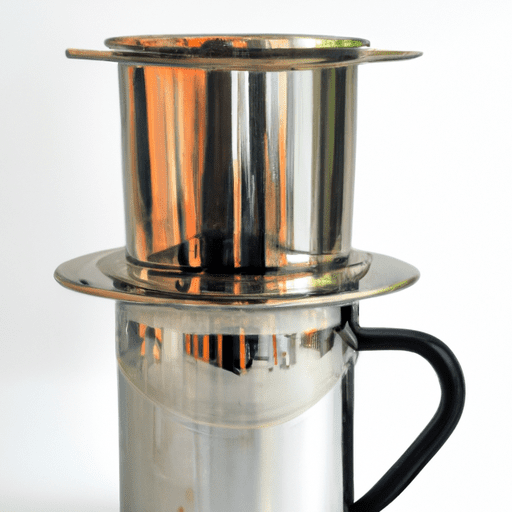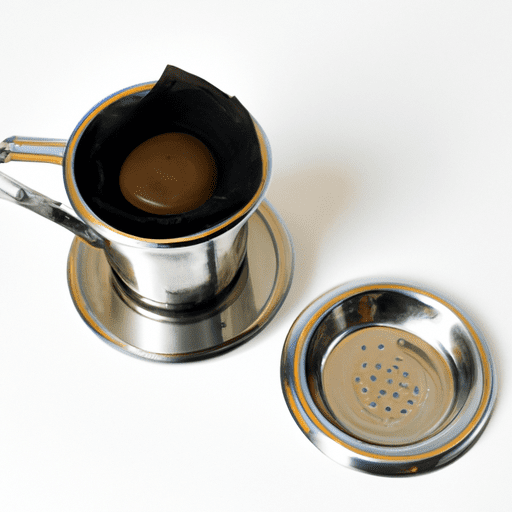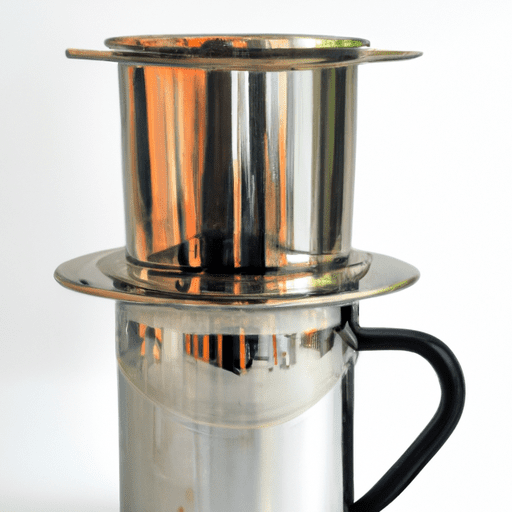You’re about to embark on a flavorful journey as you discover how to perfect the art of brewing coffee with a Vietnamese Pour Over Coffee Maker. This comprehensive guide is meticulously designed for enthusiasts like you who are passionate about their cup of joe. Get ready to enhance your skills, expand your coffee knowledge, and take your morning routine to new heights. Whether you’re an experienced barista or a newbie in the world of coffee, this guide is here to make your coffee-making experience a lot easier and much more enjoyable. Gear up to immerse yourself in the rich, fascinating world of Vietnamese Pour Over Coffee Maker—a tool that will revolutionize your coffee-brewing routine.

What is Vietnamese Pour Over Coffee?
Vietnamese Pour Over Coffee is a unique style of brewing coffee that originated in Vietnam. It uses a specific and traditional drip filter, known as a “phin,” to create a strong, bold, and robust cup of coffee. This brewing method is loved for the control it offers over the brewing process – allowing you to adjust the strength and flavor of your coffee according to your personal preference. Unlike other brewing methods, Vietnamese Pour Over Coffee does not rush the process. Each cup might take up to you five minutes to brew, ensuring the coffee grounds are fully saturated and resulting in a rich, full-bodied cup.
The Origins of Vietnamese Coffee
The story of Vietnamese coffee began in the 19th century when French colonists introduced coffee to Vietnam. Despite its tropical climate being ideal for growing coffee, Vietnam was not a coffee-drinking nation at the time. Over decades, the Vietnamese people adapted this beverage into their own unique creation by using strong, locally grown robusta coffee beans and adding sweetened condensed milk. Today, the country is the second-largest coffee producer in the world and Vietnamese coffee, with its distinctive character, has gained recognition worldwide.
The Vietnamese Coffee Filter
The Vietnamese coffee filter, also known as “phin,” is central to the preparation of Vietnamese coffee. This device is made up of four parts – a brew chamber, a perforated plate, an adjustable press, and a lid. It’s made of steel or aluminum and typically sits atop a coffee cup during brewing. The brewing process is entirely manual, requiring no electricity or expensive equipment, and gives you complete control to adjust the drip speed or the strength of the coffee.
Choosing the Right Coffee and Grind Size
Selecting the Coffee Beans
To get the most authentic experience, you may choose from two types of Vietnamese beans – Robusta and Arabica. Vietnamese Robusta beans are strong with nutty and chocolatey notes, while Arabica beans are less acidic, smoother, and have more floral notes. However, any coffee beans can be used, depending on your personal preference. Just remember, the flavor of your coffee will hugely depend on the quality of the beans you select.
Determining the Ideal Grind Size
When it comes to grinder settings, opt for a medium to coarse grind size for Vietnamese pour-over coffee. If your grind is too fine, water may not pass through it easily, resulting in over-extracted and bitter-tasting coffee. Conversely, if your grind is too coarse, water will pass through too quickly, leading to an under-extracted and weak cup of joe.
Preparing the Coffee Maker
Cleaning the Coffee Maker
Before you start brewing, it’s crucial to clean your Vietnamese coffee maker. This is to remove any old coffee grounds or oil residue left from previous brewing sessions, ensuring a fresh taste every time. Use warm water and mild detergent, and ensure all parts of the filter are thoroughly rinsed and dried before use.
Assembling the Vietnamese Coffee Filter
After cleaning the coffee maker, it’s time to assemble the Vietnamese coffee filter. Firstly, place the brew chamber on top of a glass or cup. In this chamber, you add coffee grounds. Place the perforated plate on top of the grounds. Then, inside the chamber goes an adjustable press, used to regulate the speed of the brewing process. Finally, cover the assembly with a lid to keep the coffee warm during brewing.

Brewing Vietnamese Pour Over Coffee
Measuring the Coffee and Water Ratios
When it comes to measurement, 2 tablespoons of coffee grounds for every 6 ounces of water is a good starting ratio. Depending on your preferred strength, you can adjust this ratio to your liking.
Heating the Water
Before pouring the water, make sure it’s heated at the right temperature. For the best results, heat the water between 195 to 205 degrees Fahrenheit. If you don’t have a thermometer, you can boil the water and let it rest for about 30 seconds to reach the right temperature.
Blooming the Coffee
Blooming is the process of pre-wetting the coffee grounds to allow them to release carbon dioxide and expand before the actual brewing begins. To bloom your coffee, pour a little hot water over the grounds, just enough to wet them, and wait for about 20 to 30 seconds for the coffee to “bloom.”
Brewing the Coffee
After blooming, slowly pour the remaining water into the chamber, and cover the lid. The water will slowly drip through the coffee grounds creating a delicious and rich Vietnamese coffee. The entire brewing process should take about 4-5 minutes.
Achieving the Perfect Brew
Adjusting the Brewing Time
While brewing, if you notice the water is seeping through the filter too quickly, you may want to adjust the filter’s screw to slow down the brewing process. If it’s too slow, lightly loosen the filter. 4-5 minutes of brewing will typically yield a balanced and flavorful cup.
Fine-tuning the Brew
Always remember, brewing coffee is an art, and to master it, you need to trust your palate. Feel free to adjust the coarseness of the grind, the amount of coffee, the water temperature, and the brewing time until you have a brew that suits your specific taste preference.
Evaluating the Result
Once your coffee is ready, take a moment to evaluate the result. Is it too strong or too weak? Are you able to taste the flavor notes? Answering these questions will help you better understand how you can improve your next brewing session.
Enhancing the Flavor
Adding Condensed Milk
A traditional Vietnamese coffee is often served with sweetened condensed milk, which adds a creamy sweetness that complements the strong coffee taste. Depending on your personal sweetness preference, you can experiment with the amount you put into your brew.
Exploring Various Coffee Additions
Of course, you’re not limited to condensed milk. Feel free to get creative by adding things like a dash of cinnamon, a bit of cocoa powder, or even a shot of your favorite liqueur to give your coffee an extra kick!
Cleaning and Maintaining the Coffee Maker
Disassembling the Coffee Maker
After serving your coffee, the next step is to disassemble the coffee maker. Carefully remove all the parts and rinse them thoroughly in warm water to eliminate any remaining coffee residue.
Cleaning and Drying the Coffee Maker
Once disassembled, use warm water and mild detergent to clean each part. Make sure all the soapy water is fully rinsed off before drying. Water should be tipped out well and parts left to air dry.
Storing the Coffee Maker
Once dry, you can then re-assemble your coffee maker, ready for its next use. Store it in a dry, cool place for maximum longevity.
Common Mistakes to Avoid
Using the Wrong Coffee Grind Size
The grind size affects the taste of your coffee significantly. A fine grind will result in a bitter, over-extracted coffee, while a coarse grind will yield a weak, under-extracted coffee. Aim for a medium grind to achieve a balanced flavor.
Rushing the Brewing Process
Good coffee takes time. Rushing the brewing process will not allow the coffee grounds to fully saturate, which invariably affects the flavor of your brew. Be patient and allow the coffee to drip slowly.
Not Cleaning the Coffee Maker Properly
Failure to clean the coffee maker adequately can lead to oil and coffee buildup, causing a stale taste. Make sure to clean the coffee maker after each use.
Troubleshooting Tips
Coffee Brewing Too Slowly
If your coffee is brewing too slowly, it could be due to too fine a grind size or a tightly screwed filter. Try adjusting your grind setting or loosening the filter and see if it makes a difference.
Coffee Tasting Bitter or Weak
If your coffee tastes too bitter, the water you’re using is probably too hot. If it tastes weak, you may not be using enough coffee. Adjust the water temperature and coffee-to-water ratio accordingly.
Leakage from the Coffee Filter
Leakage from the coffee filter is often due to faulty assembly. Check if all parts are correctly fitted and that the filter is correctly positioned on top of your cup.
Getting Creative with Vietnamese Pour Over Coffee
Experimenting with Coffee Blends
Feel free to experiment with different coffee blends to discover new flavors. A blend combining robusta and arabica beans could create an entirely new taste profile that you might end up loving.
Creating Vietnamese-Style Iced Coffee
If you prefer iced coffee, try making a refreshing Vietnamese-style iced coffee by pouring your freshly brewed coffee over a glass filled with ice. Make sure the coffee is strong as the ice will dilute it. This is a perfect caffeine fix for warm weather days.
Using the Coffee Maker for Tea
Your Vietnamese coffee maker is not just for coffee. You can also use it for brewing tea! Simply replace the coffee grounds with loose tea leaves and enjoy a delicious cup of tea. This versatility further proves the worth of this awesome brewing tool.
That’s it, folks! You’re now ready to start brewing and enjoying Vietnamese Pour Over Coffee like a pro! It might seem like a lot to manage at first, but with time and practice, you’ll find your perfect brew. And remember, coffee brewing is not a chore, but a soothing ritual meant to be enjoyed. Happy brewing!
